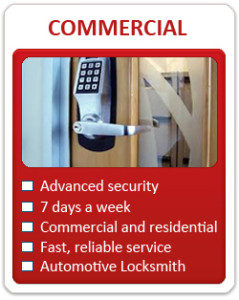Kitchener Electromagnetic Lock
Kitchener Locksmith 519-489-2586
Kitchener Electromagnetic Lock
Kitchener Electromagnetic Lock
An Electromagnet (EM) Lock is a locking device that consists of an electromagnet and an armature plate. There are four main types: U-bracket for glass door without frame, L-bracket for a narrow door frame, LZ-bracket for in-swing door and the regular installation lock.
How It Works
The concepts of electromagnetism apply here. When energized, a current  passes through the electromagnet and attracts the armature plate with such a force that it shuts down the door. When both the plates attach with each other, they are literally inseparable unless made to do so using the valid key. That valid key is what is called the switch meaning the tool that can break the strong magnetic field.
passes through the electromagnet and attracts the armature plate with such a force that it shuts down the door. When both the plates attach with each other, they are literally inseparable unless made to do so using the valid key. That valid key is what is called the switch meaning the tool that can break the strong magnetic field.
An Electromagnetic manufacturer has to ensure that wiring inside the plates is done with no fault. Electromagnets have a high attracting power because of a high flux density created by the magnetic field of the coil inside the device. This is because of the solenoid wire inside.
And this is the precise reason why use of such a device is a safe option.
Installation
EM locks installation should always be done on the inside (the secure side). Most installations are surface mounted. For safety reasons, cables and wires should be inserted in the door.
Installation is quite easy but there are different methods of installation for different types for e.g. the installations of a U-bracket would be different from that of an L-bracket lock.
- Strong and sturdy
- Easy to install
- Huge magnetic holding force (safe)
- Very suitable for emergency and fire exits
- Quick to operate
- Disadvantages
- Requires a power source continuously
- Can be disconnected in the event of a power outage disabling security
- Expensive compared to the mechanical locks
Categorization
An EM lock is categorized as a “fail-safe” and “fail-secure” device.
With fail-safe, when power is lost from the device, the lock automatically de-energizes and releases allowing free access. Whereas in fail-secure, power loss is not a concern as it remains intact.
Hence, a fail-secure device is your best friend in a panic room situation (for thieves and burglars) as it won’t open without electricity and a key, while a fail-safe device is useful in an emergency situation (in case of fire).
Conclusion
In modern times the use of such devices are on a rise which is an excellent tool in the field of security. Compared to its mechanical counterpart, it sure bags points for being a safer option. However, the most important aspect of the device is its dependence on power. How the future can help in resolving this issue remains to be seen!